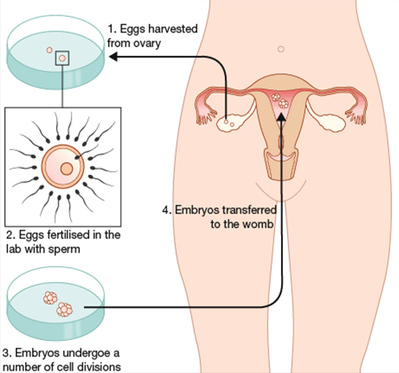
I first heard about the Designer Baby from a friend and was conflicted on my feelings about it. In Vitro Fertilization is the real name for the process and is most commonly used to screen embryos for a genetic disease or disorder and provide families that can not get pregnant the opportunity to have a child of their own. But the general misconception with IVF is that people think it is the same as having a,“Designer Baby”. The name Designer Baby comes from the part of IVF where the parent could change the features of their embryo. Having a designer baby is a science of the future that many scientists are not even sure they want to exist themselves. Screening embryos for a genetic disease and disorder is a great thing for giving birth to a healthy baby, yet deciding the genes of your child seems against nature. The exciting thing about having a baby is that you don’t know what to expect and can only guess what your child look like by looking at the features of you and your partner’s families. Choosing the genetic makeup of your baby is almost like giving your embryo plastic surgery. Although contrary to popular belief, IVF and the Designer Baby are different.

How In Vitro Fertilization works is, the doctor will fertilize a female’s eggs with a man’s sperm in a test tube. They then can legally change the sex of the child, its genes, and check for genetic disease and disorder. Next the embryo is planted back inside the mother’s womb. The process is used frequently used by older women who want to reduce the risk of a miscarriage, same sex couples, and couples who want to avoid disease in their children. The Designer Baby has the same process except would be used mainly to choose the genetic makeup of the child's features opposed to disease and the guarantee of having a child. In the future the technology may be so advanced the doctors will be able to replace defective pieces of DNA with healthy sections of DNA. This is called germ line therapy and has been tested successfully on animals, but is illegal to use on humans. Yet doctors are able to perform body cell gene therapy which can modify defective genes in children or adults with diseases like cystic fibrosis.

Even though IVF is a costly procedure, it’s very popular in America. A report from the Society for Assisted Reproductive Technology in 2012, showed that 61,740 babies have been born in the U.S using IVF. Yet heterosexual couples aren’t the only ones using the In Vitro method. IVF gives same sex couples the opportunity to have a child of their own and is very popular in the LGBTQ community. Many same sex couples have shared their amazing experiences with using the In Vitro method and are sincerely grateful that the option existed. Jen and Kelly M. from New Hampshire said “Being 42 years old, we knew it may never happen. Your knowledgeable presence and willingness to guide us, ultimately blessed us with twin baby girls. Additionally, being an interracial, lesbian couple, we expected obstacles and resistance. Every step of the way, IVF New England treated us respectfully and professionally and embraced our diversity with ease. From the bottom of our hearts, we sincerely thank you.” With the number of success rates through IVF, having a Designer Baby would probably be as successful, but for different reasons.

The strange thing about the Designer Baby is that it’s basically like Build a Bear Workshop for your child. I decided to get a second opinion to see if I was the only one who felt uncomfortable with the idea. A classmate of mine Sally said ,“I think Designer Babies are ok as long as they aren’t modifying the physical appearance. People that are born (naturally) with cool features should own that or if you’re not then you should own that too.” Sally had a strong argument, people shouldn’t be birthed with the idea that they were created to be beautiful and not unique and original. If I was a Designer Baby it would be almost impossible to not let my looks and sex define me since it was specifically chosen for me to look and be that way.

When science plays with the natural order of things the experiment will either benefit society or it won’t, and in the case of Designer Babies, we can’t really be sure which one it will be. So if scientists are choosing to debate over the exception of Designer Babies, the people should too. So far it’s nothing to worry about since it doesn’t exactly exist yet, but with all the new technology being invented everyday it isn’t unlikely that the Designer Baby won’t become real, soon. So all we can do, is wait and see what the future has to hold.


